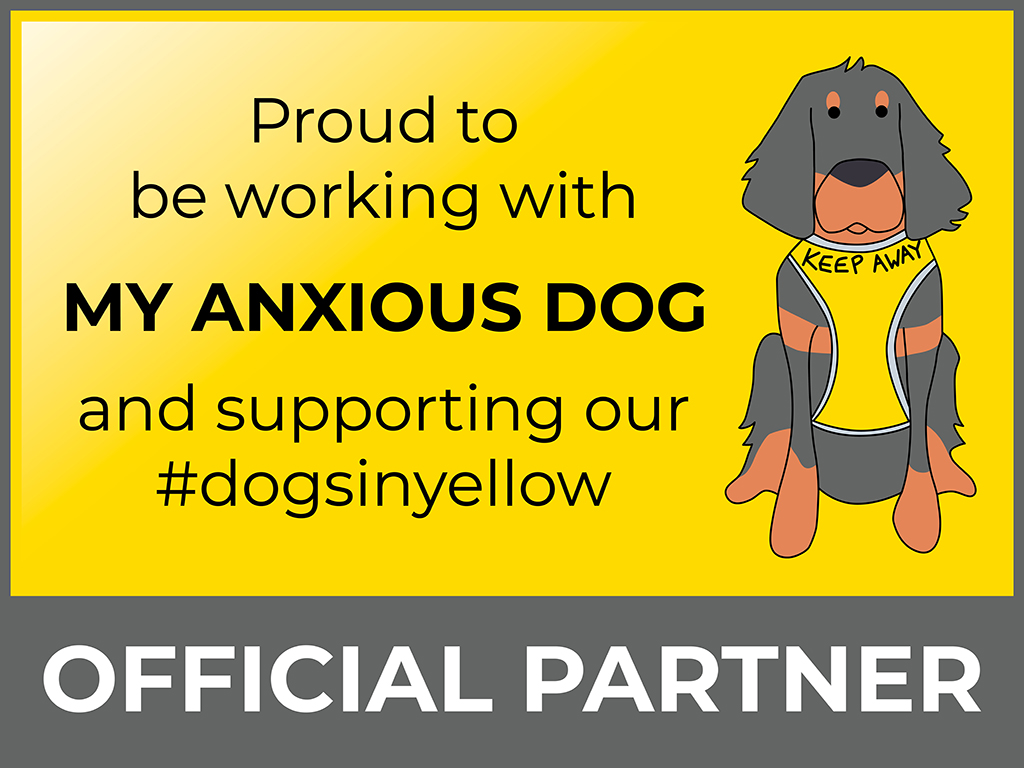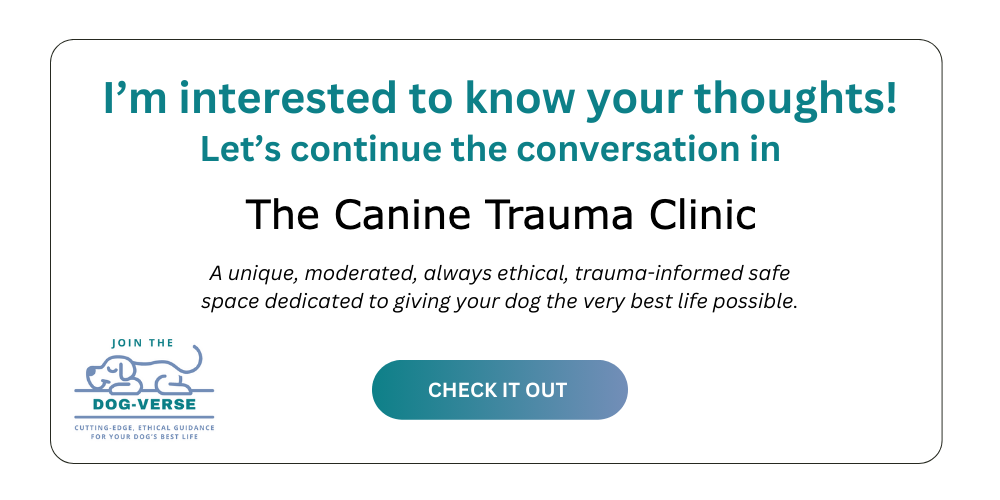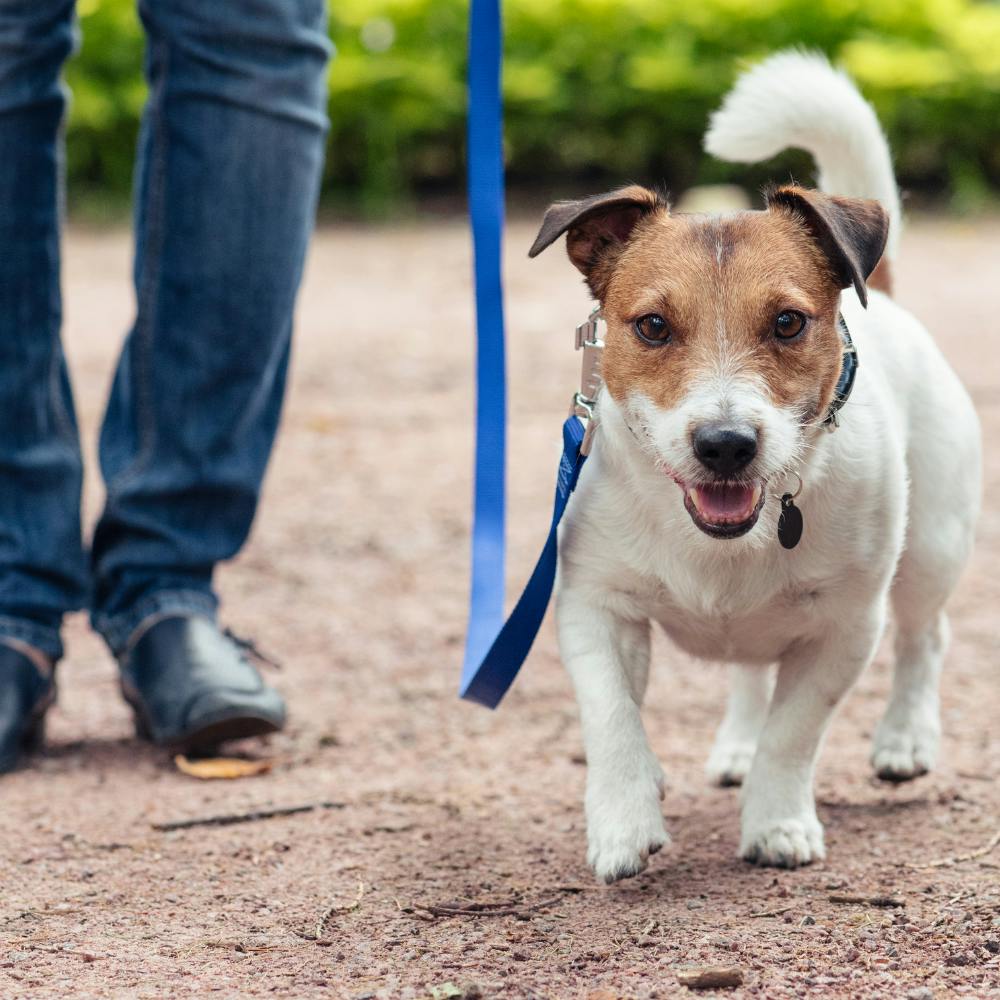By Annie Phenix, ACB-KSA
My dog Finn is a Red Heeler based on his DNA, with some Border Collie and German Shepherd thrown in the mix for good measure. And by good measure, I mean Finn’s genetic coding includes herding and protection drives as well as an instinct to bite something to move it or to change the environment – usually in the form of cattle but a heeler with no cattle can nip/bite at the humans in his environment. As we professional trainers say often: any dog with teeth is capable of biting. It just happens that the propensity to want to bite is bred into heelers as a feature to help move cattle, which is why they are also called Australian Cattle Dogs.
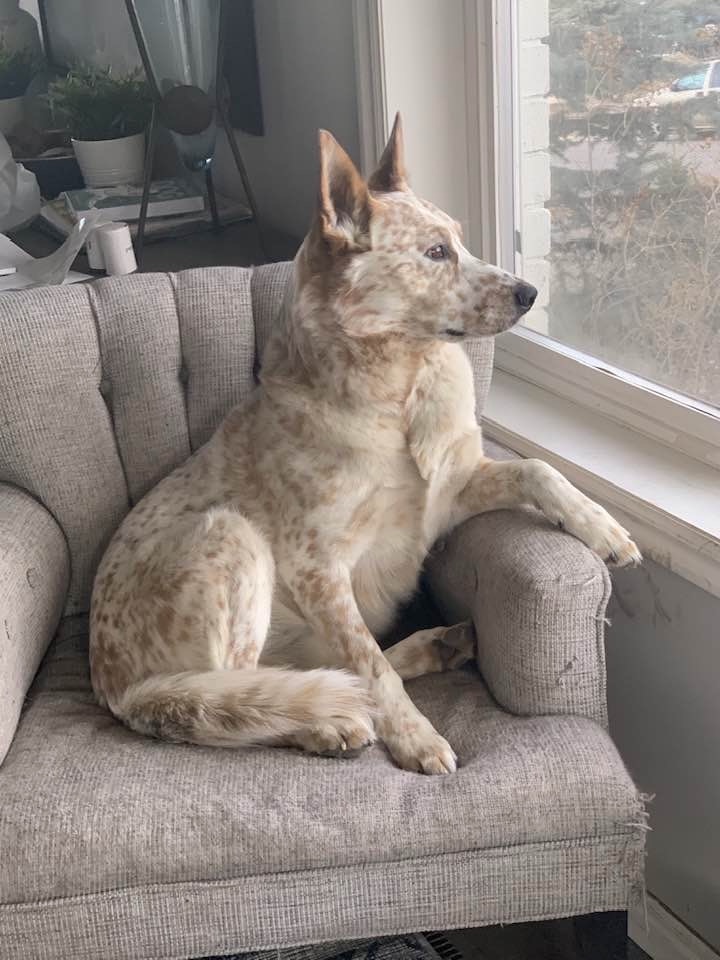
she explains why in her blog out for National Dog Bite Awareness Month.
Here’s what Wikipedia says about heelers:
“The Australian Cattle Dog can be the friendliest of companions although it is quick to respond to the emotions of its owners, and may defend them without waiting for a command. It was originally bred to move reluctant cattle by biting, and it will bite if treated harshly. The Australian Cattle Dog’s protective nature and tendency to nip at heels can be dangerous as the dog grows into an adult if unwanted behaviours are left unchecked.”
Finn suffered an enormous, early trauma when he was cruelly removed from his mother at 5 weeks of age, thereby missing important nurturance and guidance. His nature is one of a sweet dog mixed with anxiety and hyper vigilance. Because of his vast early trauma that included being left alone in a back yard to fight for his food and own safety at 5 weeks of age, I knew he needed all of my experience as a behavior expert helping dogs learn to regulate their nervous systems and live their best, most joyful lives without feeling the need to bite. I also know that Finn would not be alive at age 5 had he not come to live with me or someone like me with years of experience helping sensitive dogs who happen to be bred to use their teeth to solve problems. All dogs deserve humane treatment and they should never be harmed in the name of training – even a dog that wants to bite. In fact, an anxious dog needs to feel even more secure and safe than a well-adjusted dog might need and punishment never heals anxiety.
Finn has never put his teeth on anyone — except for myself and my husband. He’s “bitten” us three times. I put the word “bite” in quotes because while he technically DID put his teeth on our skin and it looked like he was going in for a bite, we had no puncture wounds or even a bruise – meaning Finn has exquisite bite control over his powerful teeth and jaw muscles. He is big for a Heeler – 80 pounds he has one of the strongest grips of any dog I have felt (I know this from the bite work games we play). Yes, he’s put his mouth on us three times and not once did I think he might need to euthanized or treated harshly for using his teeth.*
Let me explain why.

(And no, for the punish-loving shock collar trainers of the world, I am most certainly not saying it is okay for dogs to bite humans. Let’s bring back the concept of having common sense and not just be reactionary humans for ego’s sake, shall we?)
Bite #1 was my fault entirely.
We acclimated Finn and his full brother Cooper to experiences they would have throughout their lives in a safe way when they were puppies, including introducing them to clipping their nails. Cooper is more laid back than Finn and as he grew, he was fine with grooming. Finn was not and when he became a full adult dog he gave me one deep growl of a warning that I took very seriously (you would too if you’ve ever been growled at in this manner). His growl told me that he no longer wanted me to touch his front paws to trim his nails. Many dogs object to their front paws being handled. So instead of a relationship-changing battle of human ego or labeling Finn a “bad dog,” I simply made trimming his front paws a game for him by using a scratch board (Check out this scratch board).
Once and once only, I broke our “agreement” and moved to clip a long nail that the scratch board didn’t get to on his front paw. Finn slipped out of his collar that my husband was holding and he put his strong mouth on my hand faster than a blink. It worked – I dropped the clippers as I watched and marveled as I felt him stop his bite before it left a mark. I felt him control and release his grip. It was a warning I heeded and we now always use the scratch board for his front paws. Problem solved and future bites around nail clippings (and stress) avoided.
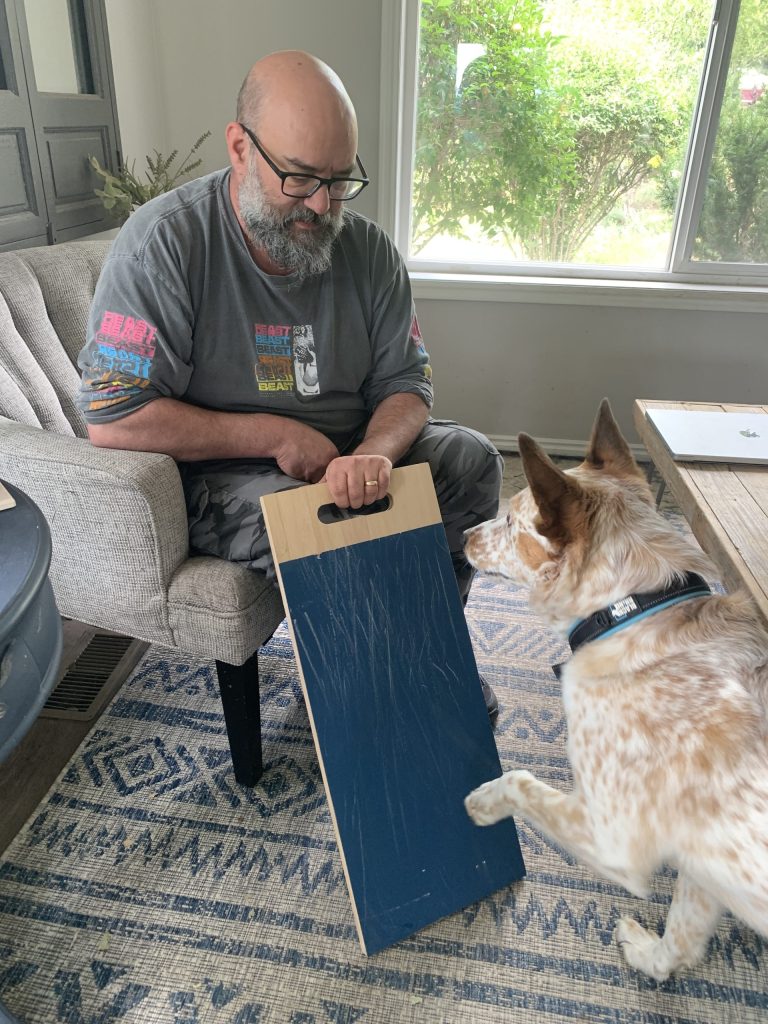
Bite #2 was a fear-induced environmental scare.
Even the most docile family pet can bite when scared or hurt. One day Cooper somehow got his paw deeply imbedded on a sharp metal point that had come loose in our fence and he was screaming in pain. My husband got to Cooper before I did and was working hard to get Cooper’s paw untangled from the metal, all while Cooper was writhing in pain and vocalizing loudly. Finn as there too and he panicked. Cooper did not bite even while in pain, it should be noted. Finn tried. He went in several times and air snapped at my husband, and then at me as I grabbed Finn by his collar to move him out of the area. Finn was over threshold in a state of worry/fear/stress at this point and he tried to wiggle out of collar by throwing his body at mine. Had he wanted to connect his teeth to my arm, he would have.
Luckily my husband got Cooper out of the fence and he stopped screaming, calming down the situation. Finn was stressed hearing the sounds of distress from his brother and he responded with his body, which included his teeth. He did put his mouth on both humans in this situation but once again without even one puncture mark. I once counseled a kind couple who were in shock after the husband didn’t see their dog and ran over it backing up a horse trailer. The dog was gravely injured and crying in pain when the dog’s best friend and resident dog rushed in and killed the dog that had been run over. Think about that canine response and how we humans would label this dog and how we might respond. For all we know, Finn and the other dog did what their brains and genes told them to do to stop the pain they were seeing in their fellow dogs. Or, more likely, they reacted in the moment to a highy stressful situation in a way that their nervous system directed them to respond: fight, flight, freeze, fawn or fidget.
We humans don’t even know how we are going to react when we are confronted with a high stress situation but one reaction we all have access to is to fight. Often our bodies can and do respond before we have a moment to think through a scary scene in front of us. Our stress reactions can even make the situation far worse. Dogs have the same kind of nervous system and brain development that we do and they can also respond in the moment to such a stressful event. Had Finn bitten us just then, I would understand why. He didn’t though, and that I find remarkable and the hallmark of a very good dog indeed. Same for his brother Cooper.
Bite #3: Accidents Happen
We humans can yell or even swing at someone we love dearly when we are greatly startled by something that scares us or hurts us deeply (I am not excusing violent human behavior – here I am talking about a human stress response to being startled or deeply frightened).
My husband and I and the two heelers set out as we do daily on a leash walk in our neighborhood. The sun was shining and everything was grand — until Finn happened to walk right in front of Jeff just as a neighbor was pulling out of his driveway and didn’t seem to see us. Jeff was waving to the neighbor to get his attention and he didn’t see Finn cross in front of him and he stepped hard on Finn’s back foot by accident.
Finn yelped and again faster than your eye can blink, Finn jumped at the hand that held the leash and he bit Jeff. He actually bit Jeff’s arm that thankfully was underneath a heavy flannel coat (no rip or tear to the coat). I was standing next to Jeff frozen for a split second as it was a shock to see Finn biting my husband. Finn next sat down and to my surprise, he jumped at Jeff again and connected his teeth with his hand – the leash holding hand. By this time I moved out from my state of shock and grabbed the leash and pulled Finn away. Finn was shaking and leaned against me for comfort, which I gave him.

Jeff’s hand hurt a little, but there were no marks. Finn bit when he was accidentally stepped on but once again, he showed tremendous restraint and did not bite with force. He bit because he was hurt and afraid by an accident. He bit because his amygdala directed him to react to self-protect before the front part of his brain could access the real threat. We humans can do the exact same thing.
What if my husband in his own stress reaction (or worse he reacted from a state of machismo) hit Finn in this moment? It would not have gone well for either of them and since Finn has the stronger teeth, I can tell you who would have had more physical damage. Instead, my lovely husband never thought he should punish Finn for this natural reaction to pain. Jeff sat on the ground and comforted Finn and helped him to recover from the accident. All was forgiven in an instance. (NOTE: we do not have children but if we did, we would increase the supervision and separation of Finn from kids. No child has walked Finn nor would we ever allow a child or stranger to handle Finn).
Dogs have teeth and any animal with teeth can bite. Owners need to understand canine stress and low levels of concern shown in canine body language to help reduce the stress on dog’s lives and to stop a bite before it happens. We need to remove reasons for dogs to bite, including always supervising children around dogs. We need to give dogs more understanding when they do resort to self-protection and use their teeth by understanding our role in dog bites and working hard to avoid situations that cause them.
* We are of course monitoring Finn and should his behavior change and he ever uses pressure when he puts his mouth on me or my husband, we will adapt and respond immediately. As I wrote above, any dog with teeth can bite. A dog bred to bite cattle has in its genetic code to bite to move cows – bite to make things happen or stop happening. Finn has so far not left a bruise or mark on us in the three mouth clamping incidents. If that changes, we will make swift changes to help him – all while having the knowledge that biting is not uncommon in this breed. We do not believe that anyone is in danger from Finn as he is not interacting with strangers or house guests, but should that change, we will help him and keep safety top of mind.
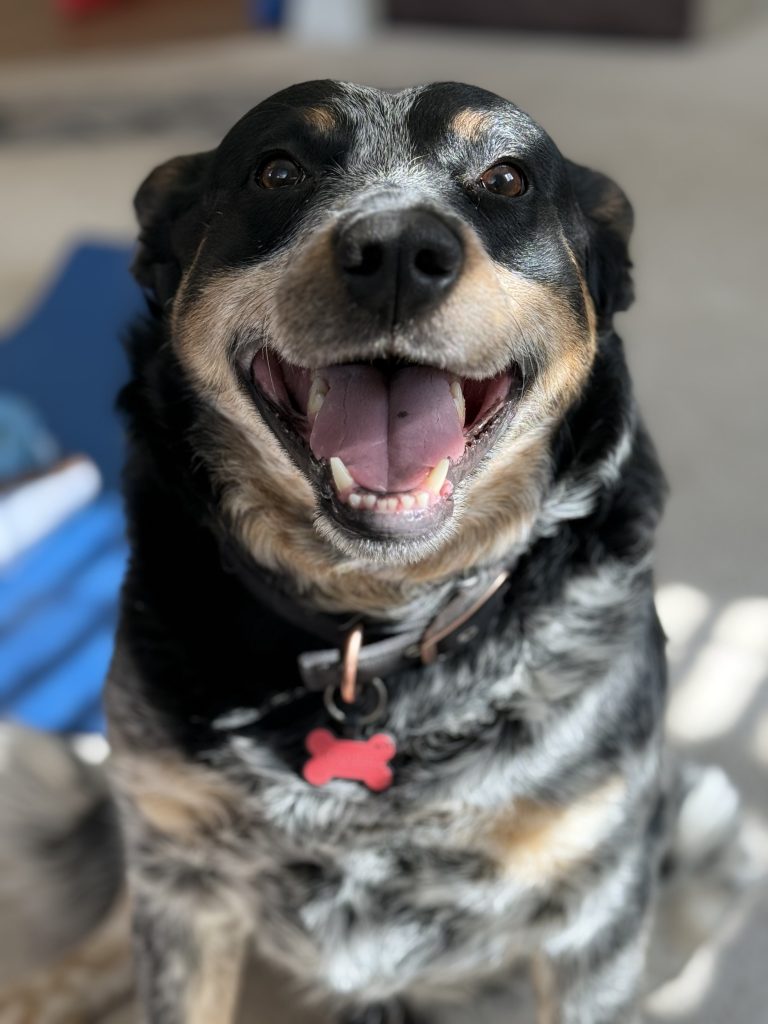
As we are taking about dog bites during National Bite Prevention Week, here are some things owners must know:
√ The average dog has an impressive bite force of 235 pounds per square inch.
√ A dog can bite approximately 15 to 25 times within a few seconds, depending on factors like size and the dog’s experience with the situation. This translates to roughly 30 to 50 bites per minute
√ The AVMA estimates that nearly 4.5 million Americans suffer dog bites each year. Although not all of these incidents result in insurance claims, insurers pay out roughly $1.2 billion for dog bites annually, with an average cost of nearly $60,000 per claim
√ Evaluating dog bite levels from Cattle Dog Publishing:
https://cattledogpublishing.com/blog/was-it-just-a-little-bite-or-more-evaluating-bite-levels-in-dogs/
√ Read about dog bite prevention tips from the AMVA:
https://www.avma.org/resources-tools/pet-owners/dog-bite-prevention
# # #
If you would like professional help with your dog that is always modern, ethical and humane, email me: annie@phenixdogs.com
Looking for one-on-one help? Visit my website and find a consult or course that is just right for you!
www.ChoosetoTrainHumane.com
And you can join me FREE in our online, safe, supportive and always ethical dog community, The Canine Trauma Clinic.
Annie Phenix, ACB- KSA, has achieved many certifications including Certified Canine Behaviourist (INTODogs), Family Dog Mediator (FDM), CPDT-KA (Retired), Fear Free Certified Professional, Graduate of a Schutzhund Dog Academy, CGC Evaluator, Nose Work Instructor, and many others. She is the best-selling author of canine behavior books, including her most recent title: Positive Training for Aggressive and Reactive Dogs. Learn more about Annie on her website: www.ChoosetoTrainHumane.com
You can get a good discount from my partner My Anxious Dog – UK: CLICK HERE!
